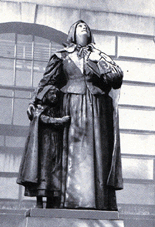Anne Hutchinson Statue

Public Art: Anne Hutchinson Statue
Sculptor: © Cyrus Edwin Dallin (November 22nd, 1861 – November 14th, 1944)
Date Unveiled: The $15,000 statue was unveiled in 1915, a gift of the Anne Hutchison Memorial Association and the State Federation of Women’s Clubs.
Cast By: Gorham Manufacturing Company foundry
Description: A bronze statue depicts Puritan, Anne Hutchinson, who was killed by Indians in 1643. Anne is looking towards heaven with left hand clenched to her heart and her right arm holding her child Susanna close to her side, protected by her cloak. Susanna, was the sole survivor of the attack by Siwanoy Native Americans who killed Anne Hutchinson and her family.
Location: Massachusetts State House, on south lawn near Beacon and Bow streets, Boston, Massachusetts.
Inscription:
IN MEMORY OF
ANNE MARBURY HUTCHINSON
BAPTIZED AT ALFORD
LINCOLNSHIRE ENGLAND
20*JULY*1591
KILLED BY THE INDIANS
AT EAST CHESTER NEW YORK 1643
A COURAGEOUS EXPONENT
OF CIVIL LIBERTY
AND RELIGIOUS TOLERATION
Background: Anne Hutchison was born Anne Marbury in England in 1591 the daughter of a dissident Puritan clergyman. She married William Hutchinson in 1612 and in 1634 she and her family emigrated to Massachusetts in order to escape religious persecution. Unfortunately, it didn’t fare much better across the Atlantic. Outspoken and often controversial in her views, Anne was not warmly received in the highly male-dominated environment. The Puritan clergy saw her as a threat, especially as she held strong views about equality, slavery and women’s rights. Egads! Her interpretation of the Bible often differed from that of the clergy and she especially challenged the interpretation of the story of Adam and Eve, which pretty much laid total blame of “original sin” on Eve. Which of course was used as the basis for justifying the patriarchal system of Puritan society.
It wasn’t long before her teachings attracted new followers (including men). Her home study group grew so large it had to be moved to a local church. It wasn’t surprising that Anne’s popularity was becoming a nightmare for government officials who were accountable to the Church of England. Many now viewed her as a heretic. In 1637 she was brought to trial charged with “traducing the ministers”, in other words, humiliating them by making false and malicious statements. There she was accused of violating the 5th commandment “honor thy father and mother” and leading women astray by tempting them to attend her gatherings and thus neglecting their families in the process.
Defending herself Anne, in realizing she was doomed, addressed the court with the following statement :
…you have no power over my body, neither can you do me any harme, for I am in the hands of the eternall Jehovah my Saviour, I am at his appointment, the bounds of my habitation are cast in heaven, no further doe I esteeme of any mortal man than creatures in his hand, I feare none but the great Jehovah, which hath foretold me of these things, and I doe verily beleeve that he will deliver me out of our hands, therefore take heed how you proceed against me; for I know that for this you goe about to doe to me, God will ruine you and your posterity, and this whole state.
This didn’t go down well, to say the least, and she was subsequently jeered by the crowd and called a heretic. One minister shouted, “You have stepped out of your place, you have rather been a husband than a wife, a preacher than a hearer, and a magistrate than a subject.” The court found her guilty “as being a woman not fit for our society” and banished her from the colony. At the time Anne was pregnant with her 15th child.
It didn’t end there. Another trial, this time a religious one, was held the following year in which they accused her of blasphemy and “lewd and lascivious conduct” for having men and women in her house at the same time during her Sunday meetings. She couldn’t win! Of all charges she was found guilty and as punishment was excommunicated from the Puritan Church.
Sadly for Anne, she lost her baby to a miscarriage during the trials, to which the Puritan leaders of the Massachusetts Bay Colony took great pleasuring in gloating about, calling it a judgment of God.
Meanwhile, followers who became known as the “Antinomians” were so disheartened by the colonies attitude they left to form their own little community in Rhode Island called Pocasset (now Portsmouth). This was lead by William Coddington and Anne’s husband William Hutchinson.
Following the death of her husband in 1642, Anne left Portsmouth with her family and several followers to settle in New Netherland (now known as the Bronx). Unfortunately, within less than a year Anne and her family (except for her daughter Susanna ) were dead, murdered by Siwanoy Native Americans.